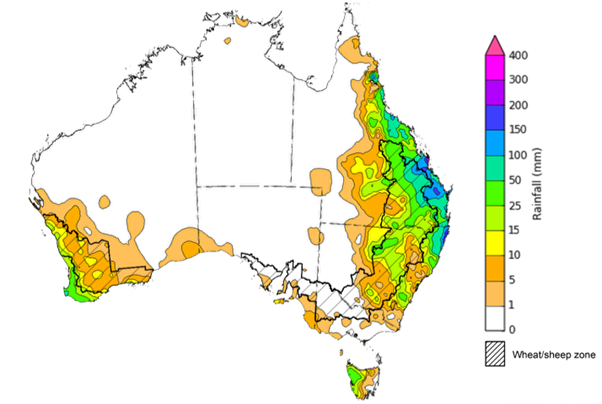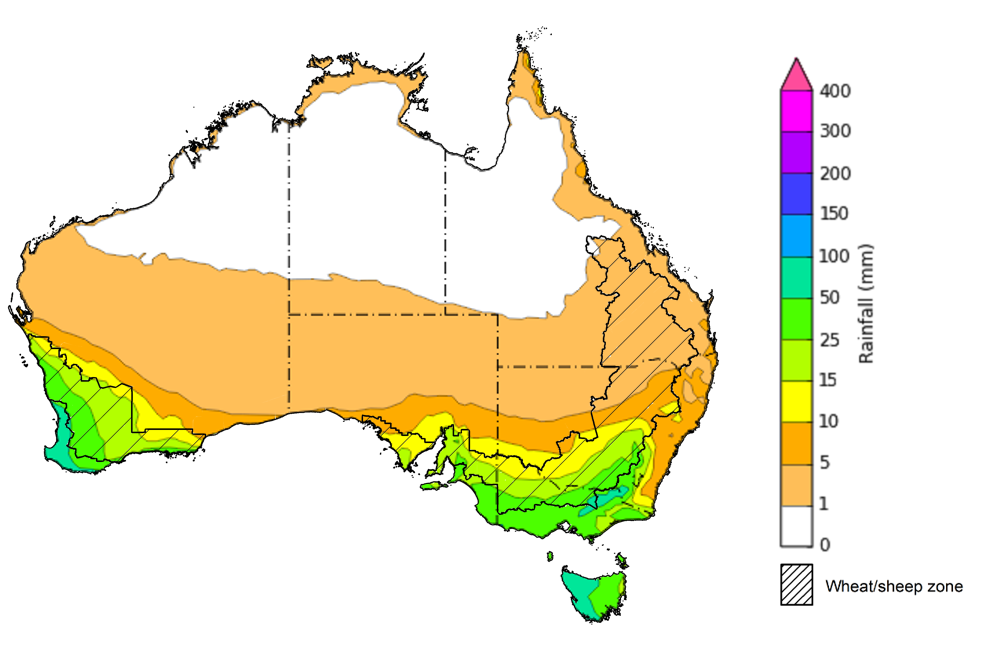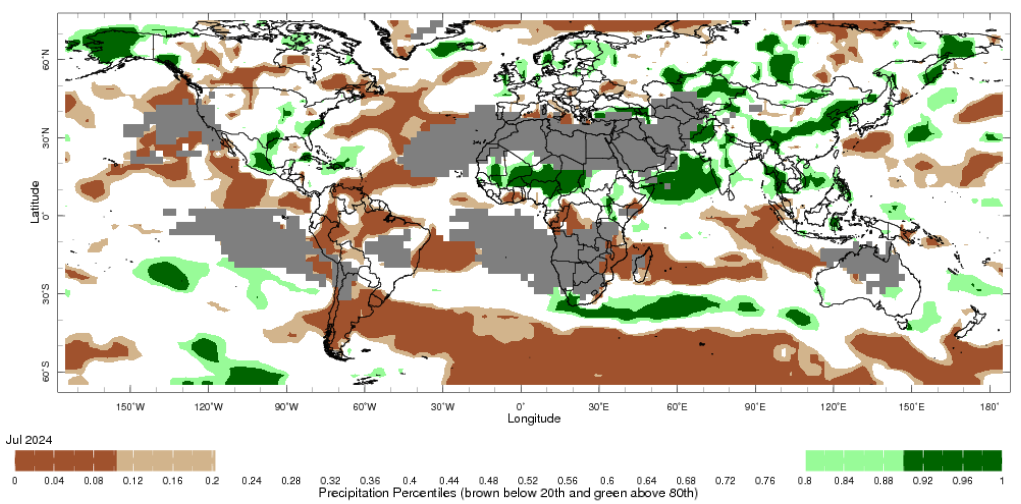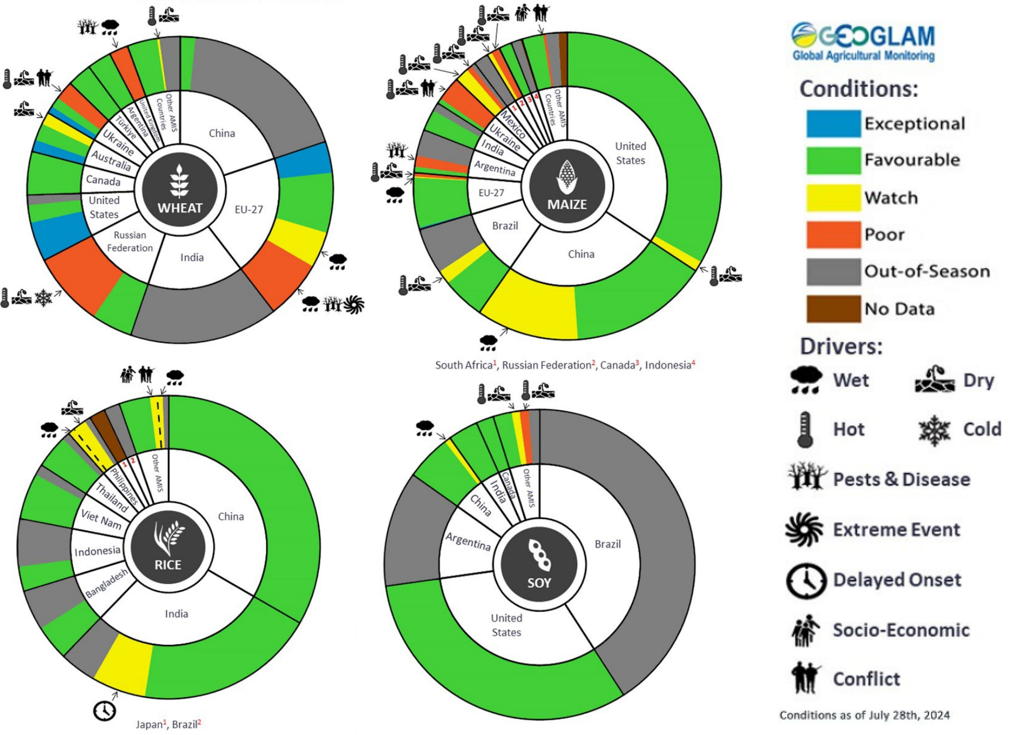Key issues
- In the week ending 14 August 2024 a series of low-pressure troughs and a low-pressure system and cold front brought rainfall totals of up to 200 millimetres to eastern Australia and up to 50 millimetres in south-west Western Australia and Tasmania.
- Across cropping regions, rainfall totals ranging from 10 to 150 millimetres were recorded in Queensland, with falls of between 5 and 50 millimetres were recorded across much of New South Wales. This rainfall will not only support the yield prospects of winter crops, but also assist in the build-up of soil moisture reserves for the timely planting of summer crops. Western Australian cropping regions recorded falls of between 5 and 25 millimetres.
- Over coming days, low-pressure systems are expected to bring rainfall to the southern half of the country. Meanwhile, a high-pressure system is expected to keep the northern half of the country dry and largely cloud free.
- Across cropping regions, rainfall totals of between 10 and 50 millimetres are forecast across Western Australia, South Australia, Victoria, and southern New South Wales. If realised, rainfall in these cropping areas is expected to provide a boost to plant growth and soil moisture levels following recent dryness.
- Globally, variable rainfall during July has led to mixed crop production prospects.
- Global production conditions were generally favourable for rice and soybeans but variable for wheat and maize.
- Global production conditions remain generally unchanged from those used to formulate ABARES forecasts of global grain supplies and world prices for 2024–25 in its June 2024 edition of the Agricultural Commodities Report.
- Water storage levels in the Murray-Darling Basin (MDB) increased between 08 August 2024 and 15 August 2024 by 91 gigalitres (GL). Current volume of water held in storage is 18 194 GL, equivalent to 82% of total storage capacity. This is 10 percent or 2,709 GL less than at the same time last year. Water storage data is sourced from the BOM.
- Allocation prices in the Victorian Murray below the Barmah Choke increased from $142 on 08 August 2024 to $146 on 15 August 2024. Prices are lower in the Murrumbidgee due to the binding of the Murrumbidgee export limit.
Climate
For the week ending 14 August 2024, a series of low-pressure troughs and a low-pressure system brought rainfall totals of up to 200 millimetres to eastern Australia. A cold front resulted in showers of up to 50 millimetres in south-west Western Australia and Tasmania. In contrast, a high-pressure system kept large parts of southern, central and northern Australia mostly dry.
Across cropping regions, rainfall totals ranging from 10 to 150 millimetres were recorded in Queensland, with falls of between 5 and 50 millimetres were recorded across much of New South Wales. This rainfall will not only support the yield prospects of winter crops, but also assist in the build-up of soil moisture reserves for the timely planting of summer crops. Western Australian cropping regions recorded falls of between 5 and 25 millimetres, with higher rainfall totals observed along western cropping margins. Little to no rainfall was recorded across much of South Australia, Victoria, and parts of southern New South Wales. This is expected to see a continued drawdown in soil moisture reserves and some moisture stress in crops with minimal soil moisture reserves.
Rainfall for the week ending 14 August 2024

Over the 8 days to 22 August 2024, low-pressure systems are expected to bring rainfall to the southern half of the country. Meanwhile, a high-pressure system will keep the northern half of the country dry and largely cloud free.
Across cropping regions, rainfall totals of between 10 and 50 millimetres are forecast across Western Australia, South Australia, Victoria, and southern New South Wales. If realised, rainfall in these cropping areas is expected to provide a boost to plant growth and soil moisture levels following recent dryness. Following a wet week, cropping regions in northern New South Wales and Queensland is forecast to receive lighter falls of up to 10 millimetres.
Total forecast rainfall for the period 15 August to 22 August 2024

Crop production is affected by long-term trends in average rainfall and temperature, interannual climate variability, shocks during specific growth stages, and extreme weather events. Some crops are more tolerant than others to certain types of stresses, and at each growth stage, different types of stresses affect each crop species in different ways.
The precipitation anomalies and outlooks presented here give an indication of the current and future state of production conditions for the major grain and oilseed producing countries which are responsible for over 80% of global production. This is an important input to assessing the global grain supply outlook.
July precipitation percentiles and current production conditions
As of the end of July 2024, rainfall was variable for the world’s major grain- and oilseed-producing nations.
In the southern hemisphere, precipitation was below average across much of Argentina and parts of northern and southern Brazil. In contrast, parts of western Australia experienced above average rainfall. Rainfall was generally average in the remaining grain- and oilseed-producing regions in the southern hemisphere.
In the northern hemisphere, precipitation was below average in parts of southern and eastern Europe, central and southern Canada and parts of the northern United States. Precipitation was generally average to above average in the remaining grain- and oilseed-producing nations in the northern hemisphere.
Global precipitation percentiles, July 2024

As of 28 July 2024, global production conditions were generally favourable for rice and soybeans but variable for wheat and maize:
- Wheat – in the northern hemisphere the winter wheat harvest is progressing under variable conditions, with areas of concern in parts of Europe, the Russian Federation, and Ukraine, following adverse weather conditions in recent months. However, above average yields are expected elsewhere in Europe and in the United States and Canada. In the southern hemisphere crops are developing under generally favourable conditions in Australia and Argentina.
- Maize – in the southern hemisphere, the harvest is progressing under mixed conditions in South America. In the northern hemisphere, there are areas of production concern in Mexico, the North China Plain, Romania, and Ukraine due to hot and dry conditions. Elsewhere in the northern hemisphere production conditions are generally favourable.
- Rice – conditions are generally favourable, however transplanting in parts of eastern India has been delayed due to lack of rainfall in the area.
- Soybeans – in the northern hemisphere, generally favourable production conditions persist with the exception of parts of the Russian Federation and Ukraine with some production concerns evident due to hot and dry conditions.
Crop conditions, AMIS countries, 28 July 2024

The global climate outlook for September 2024 to November 2024 indicates that mixed rainfall conditions are expected for the world’s major grain-producing and oilseed-producing regions. Outlooks and potential production impacts for the major grain and oilseed producing countries are presented in the following table.
Rainfall outlook and potential impact on the future state of production conditions between September 2024 to November 2024
| Region | September-November rainfall outlook | Potential impact on production |
|---|---|---|
| Argentina | Below average rainfall is more likely across western and eastern parts of Argentina. Average to above average is expected in the northern and southern areas. | Below average rainfall is likely to impact the heading and filling of wheat and the planting of corn, cotton and soybeans. These conditions may also present risk to early corn silking, and the planting of soybeans, sunflower, rice, sorghum and millet in November. Average to above average rainfall across parts of northern Argentina is likely to benefit corn and soybean planting and development through the September to November period. |
| Black Sea Region | Generally, average rainfall is expected, with below average rainfall in isolated areas, in Ukraine, Kazakhstan and the Russia Federation. Above average rainfall is expected in Türkiye. | Average rainfall is likely to support spring wheat harvesting in the north-east of Russia and early cotton harvesting in southern regions. Average rainfall across Kazakhstan and Ukraine is likely to support winter wheat and rapeseed planting in September, and corn and sunflower filling in September and October. |
| Brazil | Below average rainfall is more likely across northern and southern parts of Brazil. Above average rainfall in more likely in eastern Brazil. | Below average rainfall across much of Brazil is likely adversely corn and soybean planting and development in October and November. Above average rainfall in parts of eastern Brazil is likely to benefit wheat filling leading up to harvest in October, as well as corn and soybean planting and development in September and October. |
| Canada | Generally, average rainfall is likely across much of Canada. Above and below average rainfall is likely in isolated areas. | Average rainfall could be sufficient to maintain the yield potential of corn, soybeans and sunflower at the grain filling and maturing stage through September and October. |
| China | Average to above average rainfall is more likely across much of China, while below average rainfall is more likely in the western regions. | Average to above average rainfall is likely to benefit the development and harvest of cotton, corn, sorghum, soybean, sunflower, groundnuts and spring wheat across north-eastern, southern and western China. In central China, above average rainfall is likely to support the planting of winter wheat and rapeseed in October. |
| Europe | Average rainfall is more likely for much of Europe. | Average rainfall may benefit the development and harvest of corn, cotton and sorghum in western and central Europe. Average rainfall may also benefit winter wheat and rapeseed planting in parts of western and central Europe during October and November. |
| South Asia (India) | Above average rainfall is more likely across much of India. | Above average rainfall is likely to benefit cotton blooming in the south during September. It will also assist corn, sorghum, rice, millet, groundnuts and sunflower filling in September leading up to harvest in October and November, and winter wheat and rapeseed planting in November. |
| Southeast Asia (SEA) | Above average rainfall is likely across Indonesia and southern Malaysia. Average rainfall is likely in Thailand. | Above average rainfall in SEA is likely to benefit corn and rice maturing during September leading up to harvest in October. |
| The United States of America (US) | Generally, below average rainfall is likely for much of southern half of the US, with average rainfall more likely across the northern half. | Below average rainfall is likely to adversely affect the filling and maturing of soybeans, sunflower, millet, cotton, rice, corn, sorghum and groundnuts in September leading up to harvest in October and November. |
Water
Water storages, water markets and water allocations - current week
The Tableau dashboard may not meet accessibility requirements. For information about the contents of these dashboards contact ABARES.
Commodities
Information on weekly price changes in agricultural commodities is now available at the Weekly commodity price update.
